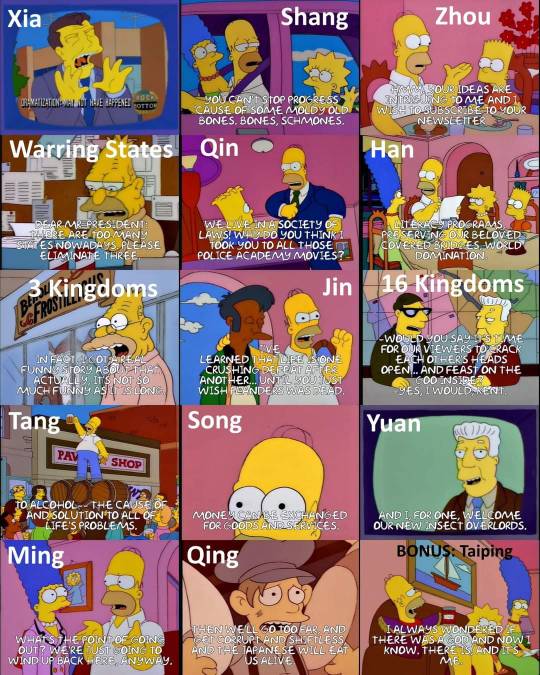Text
Please be aware that the "opt-out" choice is just a way to try to appease people. But Tumblr has not been transparent about when has data been sold and shared with AI companies, and there are sources that confirm that data has already been shared before the toggle was even provided to users.
Also, it seems to include data they should not have been able to give under any circumstance, including that of deactivated blogs, private messages and conversations, stuff from private blogs, and so on.
Do not believe that "AI companies will honor the "opt-out request retroactively". Once they've got their hands on your data (and they have), they won't be "honoring" an opt-out option retroactively. There is no way to confirm or deny what data do they have: The fact they are completely opaque on what do they currently "own" and have, means that they can do whatever they want with it. How can you prove they have your data if they don't give everyone free access to see what they've stolen already?
So, yeah, opt out of data sharing, but be aware that this isn't stopping anyone from taking your data. They already have been taking it, before you were given that option. Go and go to Tumblr's Suppport and leave your Feedback on this (politely, but firmly- not everyone in the company is responsible for this.)
Finally: Opt out is not good under any circumstance. Deactivated people can't opt out. People who have lost their passwords can't opt out. People who can't access internet or computers can't opt out. People who had their content reposted can't opt out. Dead people can't opt out. When DeviantArt released their AI image generator, saying that it wasn't trained on people who didn't consent to it, it was proven it could easily replicate the styles of people who had passed away, as seen here. So, yeah. AI companies cannot be trusted to have any sort of respect for people's data and content, because this entire thing is just a data laundering scheme.
Please do reblog for awareness.
32K notes
·
View notes
Text
All the shishi words I know
Last year I learned the word 时事, and it struck me how many shishi words there are. For fun, I listed out all the ones I'm familiar with. You can see more at MDBG (but a Chinese-Chinese dictionary would probably have many more).
世世 shìshì - from age to age
世事 shìshì - affairs of life / things of the world
事事 shìshì - everything
事实 | 事實 shìshí - fact
失事 shīshì - (of a plane, ship etc) to have an accident (plane crash, shipwreck, vehicle collision etc) / to mess things up
实事 | 實事 shíshì - fact / actual thing / practical matter
实施 | 實施 shíshī - to implement / to carry out
实时 | 實時 shíshí - (in) real time / instantaneous
时事 | 時事 shíshì - current trends / the present situation / how things are going
时时 | 時時 shíshí - often / constantly
试试 | 試試 shìshi - to have a try
逝世 shìshì - to pass away / to die
I ran some stats based on my Anki deck, and there also a lot of qishi words: 其实、气势、骑士、启示、歧视、启事. But not as many as shishi. Maybe we need a poem of shishis to go alongside the 施氏食狮史 poem?
261 notes
·
View notes
Text
its official: tumblr is selling our data to Midjourney
we'd been hearing rumors about this for a bit but now its open and out there. some details from this article

it goes without saying, but if @staff goes through with this its going to be an utter shitshow and im all but certain the website will not survive it.
53K notes
·
View notes
Text
Breakfast foods in China
Since arriving in China my typical breakfast has changed quite a lot (hello baozi and mung bean paste!) so I decided to explore some common local breakfast foods eaten in China!
包子 - Bāozi (my love)
These have been an almost consistent (excluding the lunar new year when the canteens and most cafes and restaurants closed) staple of my breakfast ever since I arrived in China. They come with several fillings such as veggie, pork, seafood etc. and they can cooked in different ways such as being steamed, fried etc. Here's a more in-depth post about the types of dumplings and bāo.
粥 - Porridge (zhōu)
I sometimes have porridge for lunch instead and it's a really filling meal. I get the Century Egg Congee with Chicken - 皮蛋瘦肉粥 (Pídàn shòu ròu zhōu) and it's one of my all time favourite meals.
煎饼 - Egg pancake (jiānbing)
Popular also as a street food, this is a thin crepe type pancake with an egg, veggie, spice, sauce and sometimes meat filling. The actual filling varies as you can customize what veggies and spice level you'd like and whether or not you want meat.
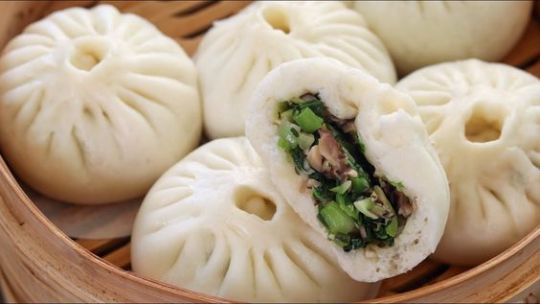
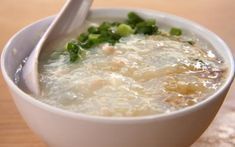

热干面 - Hot and dry noodles (règānmiàn)
I honestly had no idea about this dishes existence until a while ago, probably because it's a regional dish originating from Wuhan which is kind of far away from my location. These are spicy and dried noodles which are actually eaten without a broth unlike many other noodles. They seem pretty interesting so if anyone tried them before do share your experience!
桂林米粉 - Guilin Rice noodles (guìlín mĭfĕn)
This appears to be another regional dish from Guilin, Guanxi as I had no idea that this was a also a pretty popular breakfast dish. Apparently it's not the noodles but rather the broth that they're cooked in that makes them special, with the actual recepie varying across the region. Someone should do a long weekend trip vlog (pondering on this) to Guilin where they just go from store to store trying these noodles and trying to determine the differences.
葱油饼 - Scallion oil pancake (cōngyŏubĭng)
A tasty but heavy-ish pancake imo. These pancakes are cooked with scallions (green onion) and pan-fried to give it that crispy and chewy texture. Very tasty, but it's a little too heavy on the oil for me so I save these pancakes for special occasions instead.

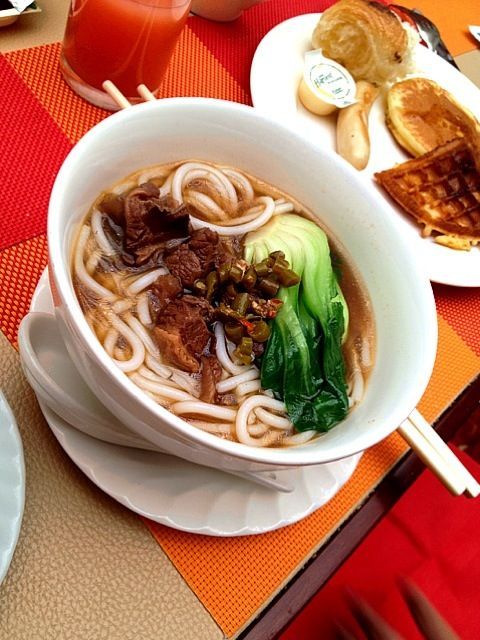
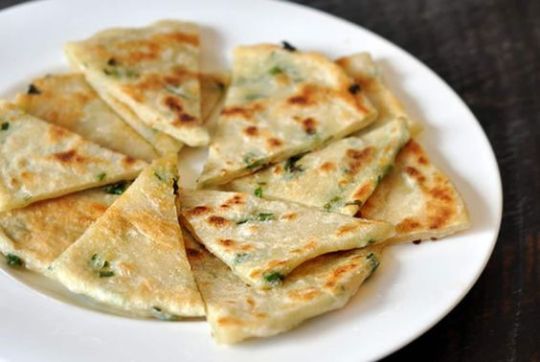
豆浆油条 - Soy milk and deep-fried dough sticks (dòujiāng yóutiáo)
I have tried the dough sticks, and I have tried soya milk but separately so far. The dough sticks are these long deep-friend dough sticks, reminding me slightly of breadsticks but more lighter and chewier.
茶鸡蛋 - Tea eggs (chájīdàn)
I adore these, my canteen serves them along with regular eggs for breakfast and the tea eggs are usually the first to go. They actually don't really involve tea, instead these eggs are cooked in a mixture of chinese five-spice powder (pepper, cloves, cinnamon, star anise and fennel seeds), soy sauce, and black tea leaves, although some recipes leave out the tea leaves.
They have a relatively strong smell so I usually grab some for breakfast on the weekends or in the canteen at lunch if there are any leftover after breakfast.
They are also quite cheap, one egg is around 2 yuan so around 0.30 euro, making them a pretty filling and affordable breakfast food.
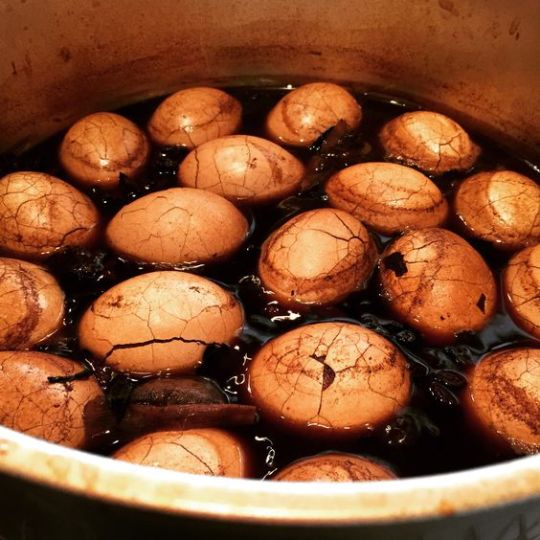

If there are any other common or specific breakfast foods that you know of, do share them please as I love trying out new things!
84 notes
·
View notes
Text

HEY YOU! Did you already go into your settings to opt out of Tumblr selling your stuff to train AI? You better do that now!
620 notes
·
View notes
Text
how i'm studying mandarin (in 2024)
as a low-maintenance language learner working a 9-6 office job, i've been muddling around how to improve my mandarin in my free time and keep it fun! And I've found what works for me (thanks to a lot of lurking on here - appreciate all you mandarin langblrs <3), so wanted to share :)
Evening lessons (or italki) - Self studying is great but I do need a kick up the ass sometimes, so these really help. Plus my teacher is great at giving tips here and there which I probably wouldn't pick up on on my own.
ChinesePod - Their podcasts are really well made and accessible, I can't recommend them enough!
HelloChinese - This is my 'I'm bored waiting for my train/bus but I still want to learn Chinese' option that isn't Duolingo. It's not perfect but it has fairly good grammar explanations and native listening segments. You do have to pay a subscription if you're over HSK1 level FYI.
I am an anki hater first and foremost, so here's the vocab learning / dictionary tools I use instead:
TofuLearn - It's straightforward, uses spaced repetition learning AND teaches you stroke order - so ticks all my boxes. Picked it up due to @marilearnsmandarin's posts about it!
Pleco - Obviously, everyone has it downloaded for a reason.
Yabla Chinese Dictionary - Not seen this one talked about so much, but would recommend! It sometimes has video examples of the hanzi in use, which I find helpful.
A big goal for me this year is to consume mandarin content more regularly! It's all well and good watching Peppa Pig, but I need something that I actively want to engage with:
Bilibili Comics - Currently reading 肉店楼上的工作室 and able to understand a fair chunk, so would recommend as a "easier" option.
Mandopop - Not sure how much I'm picking up from listening, especially at my level, but it's fun to jam out to some good tunes. Faves include TIA RAY, Song Qian, Lexie Liu, No Party for Cao Dong & Shi Shi.
Dramas/Movies - Modern chinese dramas are a lot more hit-or-miss for me, especially compared to historical/fantasy. Recent faves include Accidentally in Love & Stay with Me (on Netflix/Viki). Currently watching Reset :) Any other recs, please send my way!
YouTube - I have a separate YT account just to follow Taiwanese/Chinese creators - it takes a bit of searching but you can find some great youtubers who talk about whatever hobby you're into (whether that's cute golden retriever vlogs, travel vlogs or reading vlogs!)
364 notes
·
View notes
Text
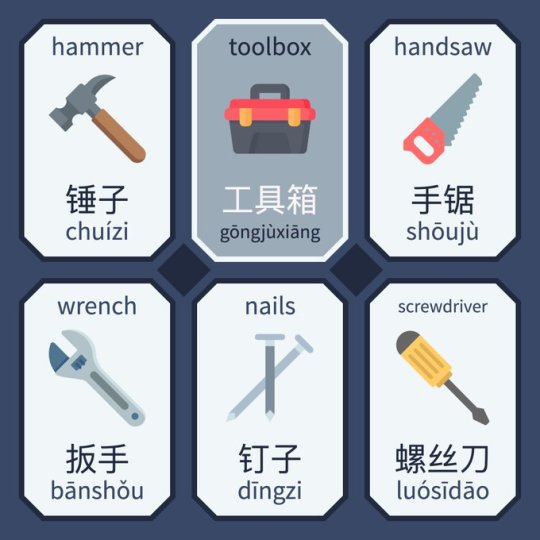
🎓 Learn Chinese Online | Learn Mandarin | Chinese Vocabularies
9 notes
·
View notes
Text
148 notes
·
View notes
Text

Peak tramway in Hong-Kong, China
Japanese vintage postcard
78 notes
·
View notes
Text

Dalian Hospital during the Japanese occupation of Manchuria, China
Japanese vintage postcard
22 notes
·
View notes
Text
So I've been playing around with Cāngjié…
And I thought a post like this (similar to a post on Zhùyīn done by linghxr) may be of interest to some.
What (and who) is Cāngjié?
For those who may not know, Cāngjié is another way to input 漢字/汉字 (Hànzì — Chinese characters). It is way less popular than Pinyin (or even Zhuyin) but it still has its fans, and has a few advantages over the other two.
Cāngjié is also the name of the mythical figure in Chinese legend who is said to have been the inventor of 漢字/汉字, for which Cāngjié (the input system) was named after.
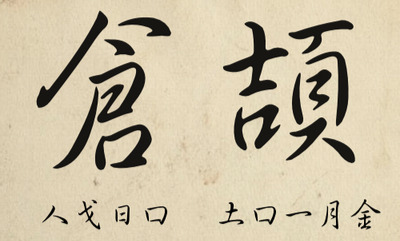
Would I recommend it?
Yes, if you think you have already acquired a good (enough) understanding of 漢字/汉字, and/or just like a new challenge.
(TL;DR at the end)
Why am I learning Cāngjié (and why you may like to, too)?
1. Mostly for fun.
Have long been intrigued by both Cāngjié and Zhùyīn, and since I finally mustered up the courage to tackle Zhùyīn not too long ago, I thought I'd finally give Cāngjié a try.
While learning Cāngjié does require more effort than learning Pinyin or Zhuyin, it can also be really fun! Inputting 漢字/汉字 with the Cāngjié method is almost like doing a jigsaw puzzle.
The euphoria derived from figuring out and piecing together the radicals that make up a word is something that learning Jyutping (Cantonese equivalent of Pinyin), Pinyin or Zhuyin can't quite match.
And while I know I'll never be as adept with Cāngjié — my knowledge of 漢字/汉字 is nowhere near good enough to ever use Cāngjié efficiently — as I do Jyutping or Pinyin (or to some extent, Zhuyin), it'll still be fun to use Cāngjié every once in a while!
2. Helps with thinking and typing in Chinese.
The upshot of relying too much on using Jyutping/Pinyin/Zhuyin is, I'd tend to think in Roman letters or ㄅㄆㄇㄈ before I'd even think about the actual 漢字/汉字.
But with Cāngjié, because it's based on knowing radicals and joining them together to form actual characters, it'll encourage thinking of 漢字/汉字 first, so I think that would help some with 漢字/汉字 memory retention.
Now you may be thinking, why not just you know, practise actually writing then? That is the tried and proven method to better remember 漢字/汉字 after all?
Yes, of course I can do that — and am doing so occasionally — but we live in a digital age now, and the probability and opportunity to type things out is much higher than actually writing stuff by hand.
The idea here is, more looking to think of and envision characters fully in my head, and trying to lessen over-reliance on Jyutping/Pinyin/Zhuyin.
And this is where I find Cāngjié can be useful, which leads to my next point…
3. Haunted by “What if” scenario.
What if there comes a day (however improbable) where I'm presented with only a Cāngjié keyboard to use for typing Chinese? It has happened with Zhùyīn for me!
That means, no Pinyin or Zhuyin keyboards, no Handwriting tools/touchscreens to write with fingers/mouse, no text-to-speech, and no option to copy-and-paste characters from somewhere else either! What then?
4. Able to type without knowing pronunciation, and with more accuracy.
Cāngjié is shape-based. Unlike Jyutping/Pinyin/Zhuyin, where you have to know what a character sounds like before you can type it out, with Cāngjié, you can type out (again assuming no Handwriting or other tools available) characters without needing to know how to pronounce them at all.
With shape-based typing, you'd also get more accurate hits in the first few 漢字/汉字 that show up, versus sound-based methods like Pinyin where for e.g., typing out “wan” will get you a whole list under the same sound and you may have to scroll through a whole lot to get the exact “wan” you need.
You can also type both Traditional and Simplified characters without having to toggle something or switch keyboards.
So how does one begin learning Cāngjié?
Install a Cāngjié keyboard.
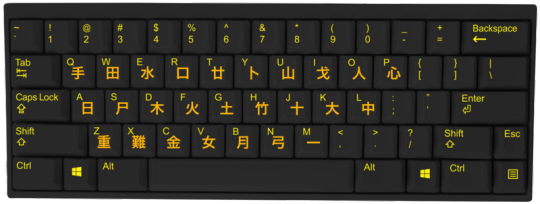
Duh…but of course! Heh! Gboard offers one, banded under Cantonese language input (Android user here, don't know about iPhones, sorry).
There are two versions of Cāngjié that are prevalent currently. Cāngjié 3 and Cāngjié 5. Cāngjié 5 is supposed to be an improvement over version 3 but I don't find there's much; having a slightly altered version just adds to the confusion and unnecessarily complicates matters, in fact!
If you have a choice, I'd recommend selecting Cāngjié 3 as that is more supported. Some operating systems may not be too compatible with Cāngjié 5 still, for some strange reason.


You may also come across something called “Quick” (速成) aka, “Simplified Cāngjié”.
This is simply a scaled down version of Cāngjié, it's still based on Cāngjié's formula. So you still need to know how Cāngjié works in order to use “Quick” efficiently.
You'd then need a chart like this. ↓

* the 重 (Z) key doesn't really come into use. I don't really know what it's for, but it seems to be used (paired with other keystrokes) mainly to type out various punctuation marks.
There are variants out there, some having a little more, or less, radicals shown than in the above example, but I'll say the chart here is one of the more comprehensive ones I've found so far (and sufficient enough) — other charts often fail to highlight the 難 (X) key and what it corresponds to.
You don't have to memorize the chart all at once. Just always have a chart like this on hand to refer to and with enough typing practise, you'll eventually remember which key corresponds with which radicals.
Remember the rules. ↓
“1 part” character (e.g. 寫) = first 3 & last (radical).
“2 parts” character (e.g. 唔) = first & last, first 2 & last.
“3 parts” character (e.g. 難) = first & last, first & last, last.
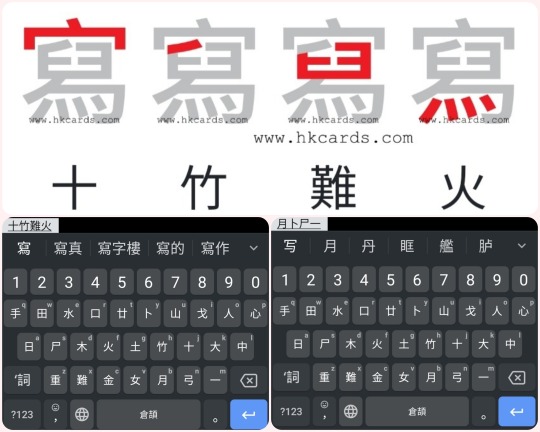
e.g. 寫 ↓
With radicals 宀,丿,臼 (first 3) and 灬 (last).
Corresponding keys: 十,竹,難 and 火。
寫 → 写 ↓
With radicals 冖,卜,㇆ (first 3),一 (last).
Corresponding keys:月,卜,尸 and 一。


e.g. 唔 ↓
With radicals 口 (first & last),一,一 (first 2),口 (last).
Corresponding keys: 口,一,一 and 口。

e.g. 難 ↓
With radicals 廿,人 (first & last),亻(first & last),土 (last).
Corresponding keys: 廿,人,人 and 土。
難 → 难 ↓
With radicals ヌ (first & last),亻(first & last),土 (last).
Corresponding keys: 水,人,and 土。
Occasionally, you may get a character that looks like a “2 parts” but is actually a “3 parts”. ↓
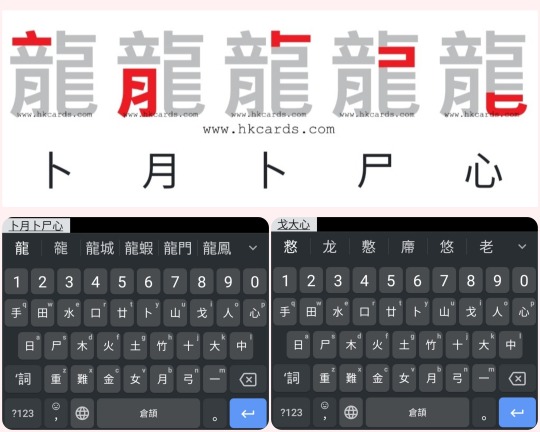
e.g. 龍 ↓
With radicals 亠,月 (first & last), 卜,コ (first & last),ヒ (last).
Corresponding keys: 卜,月,卜,尸,and 心。
龍 → 龙 ↓ (Simplified 龍 → 龙,a “1 part” character)
With radicals 丶,ナ,ヒ (first 3).
Corresponding keys: 戈,大,and 心。
Or looks like a “1 part” but really a “3 parts”. ↓
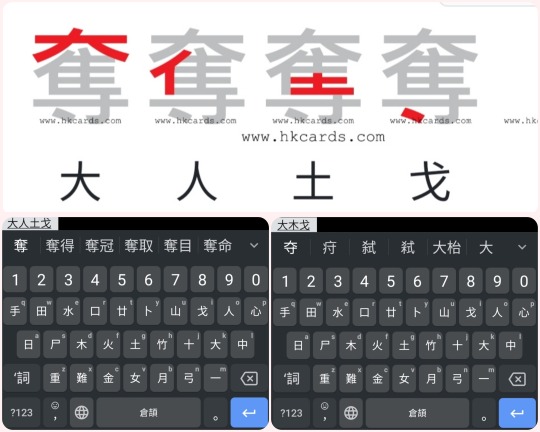
e.g. 奪 ↓
With radicals 大 (first & last),亻,土 (first & last),丶 (last).
Corresponding keys: 大,人,土,and 戈。
奪 → 夺 ↓(Simplified 奪 → 夺,a “1 part” character)
With radicals 大,寸 (first 3; the 丶 is the 3rd component).
Corresponding keys: 大,木,and 戈。
But these are exceptions, and don't occur that often.
And you can start practising!
You can try out this pretty good app called 『五色學倉頡』 (learning Cāngjié with 5 colours), for practise. It's on Playstore, just search for “Cangjie Dictionary” and it should show up.
You have to pay to unlock higher levels, unfortunately. ↓


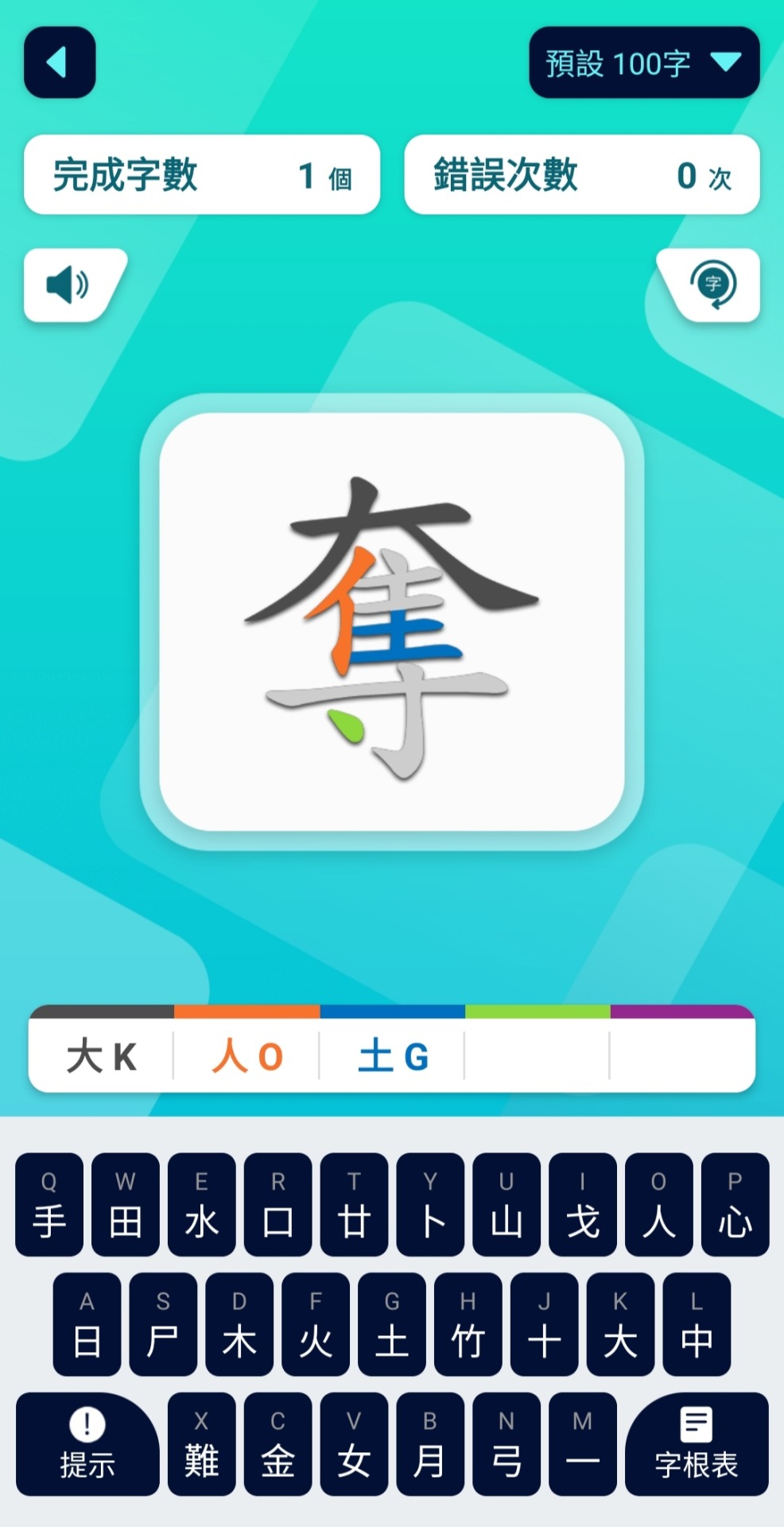
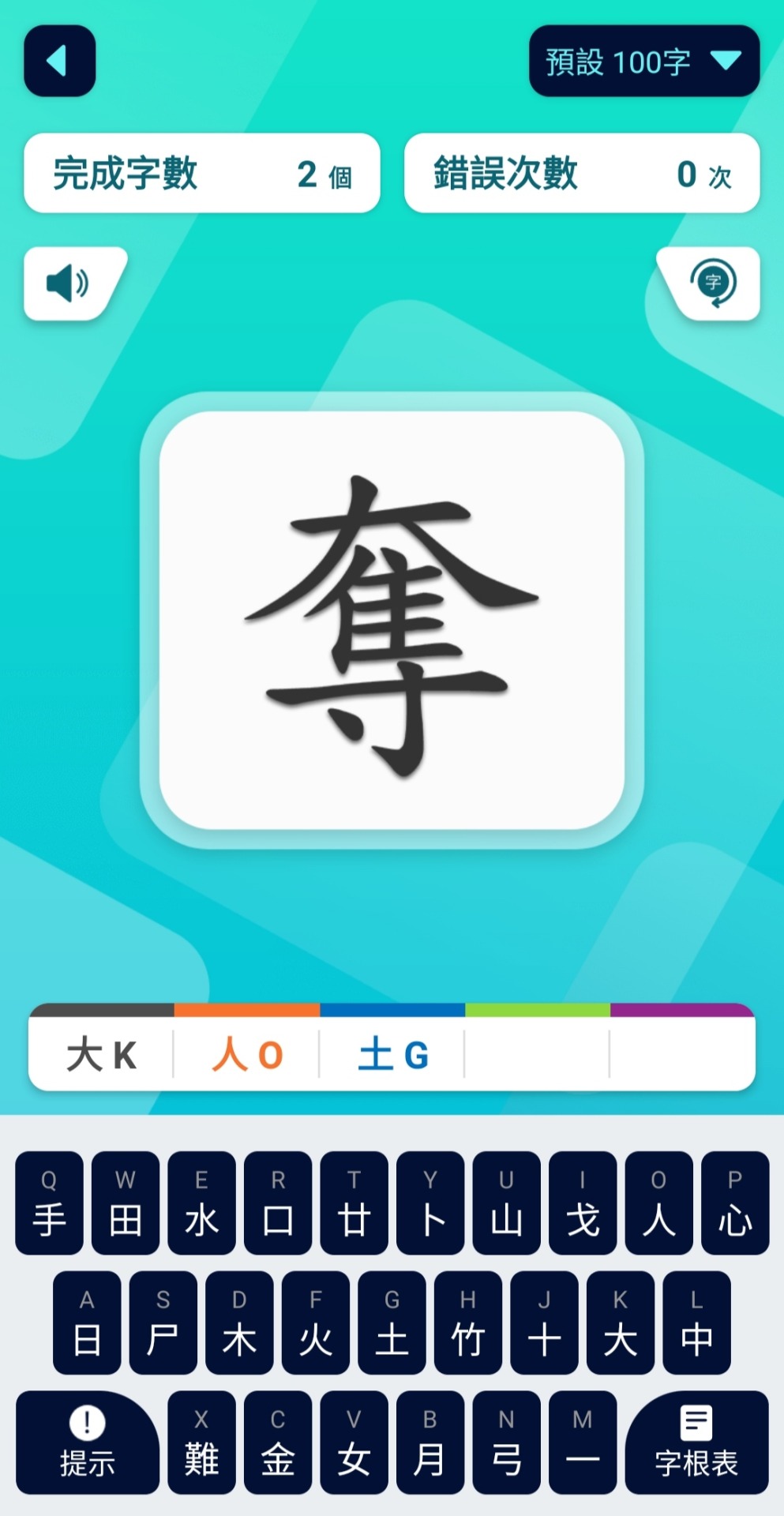

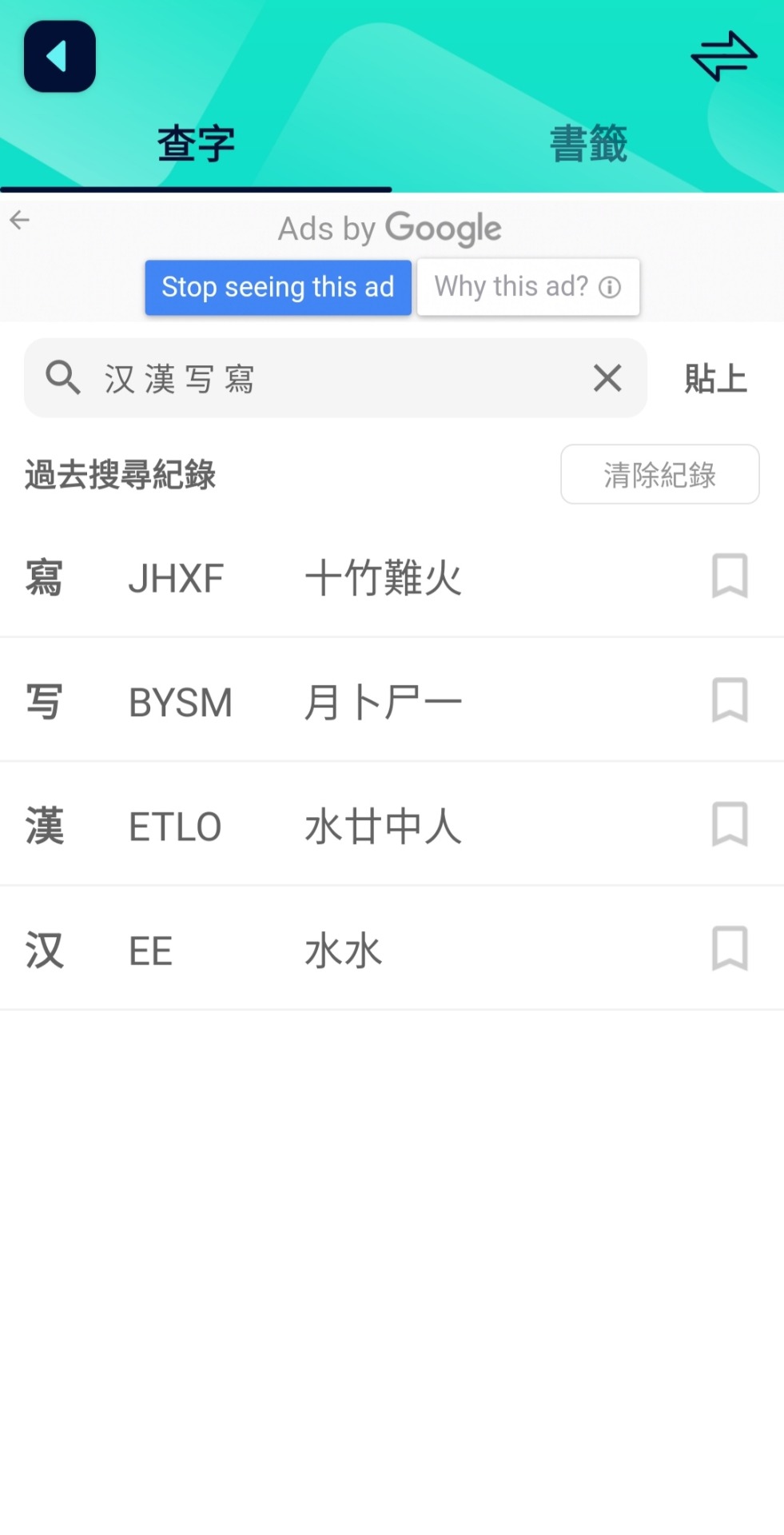
Anyway, each character comes with colour coded hints and you can opt to turn them off if you like more of a challenge. There are also hints (提示) and the chart (字根表) to refer to if you're really stuck. Also has a dictionary component (查字典) to check out the Cāngjié input for characters.
Another option would be a website called HKCards. ↓


You can use it to check the Cāngjié input for any 漢字/汉字, and there's section for practise (倉頡輸入法練習) as well. After inputting your answer with Cāngjié keys (手田水口廿卜), you can click on the “Answer” (答案) button to see how right or wrong your answers were. ↓

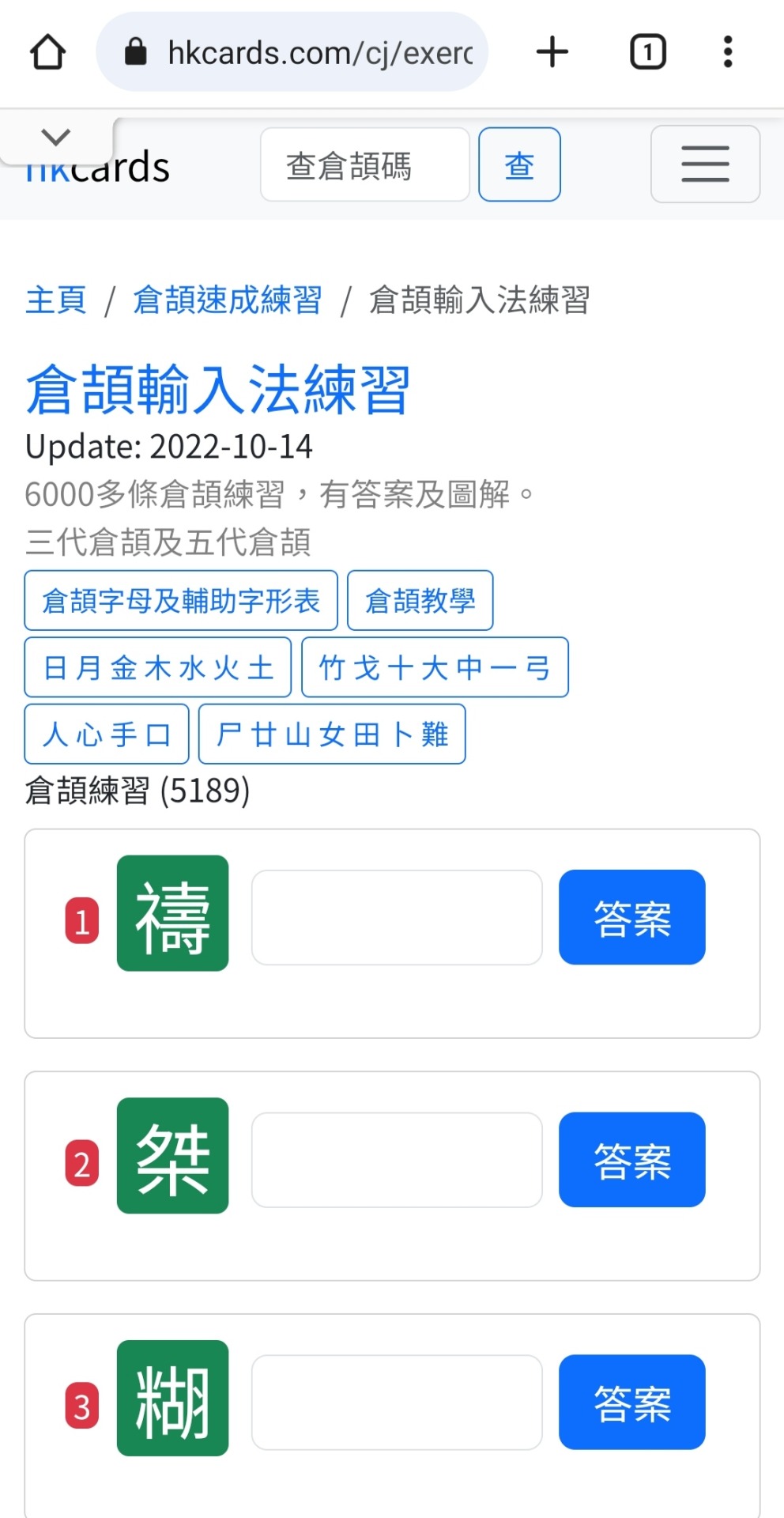
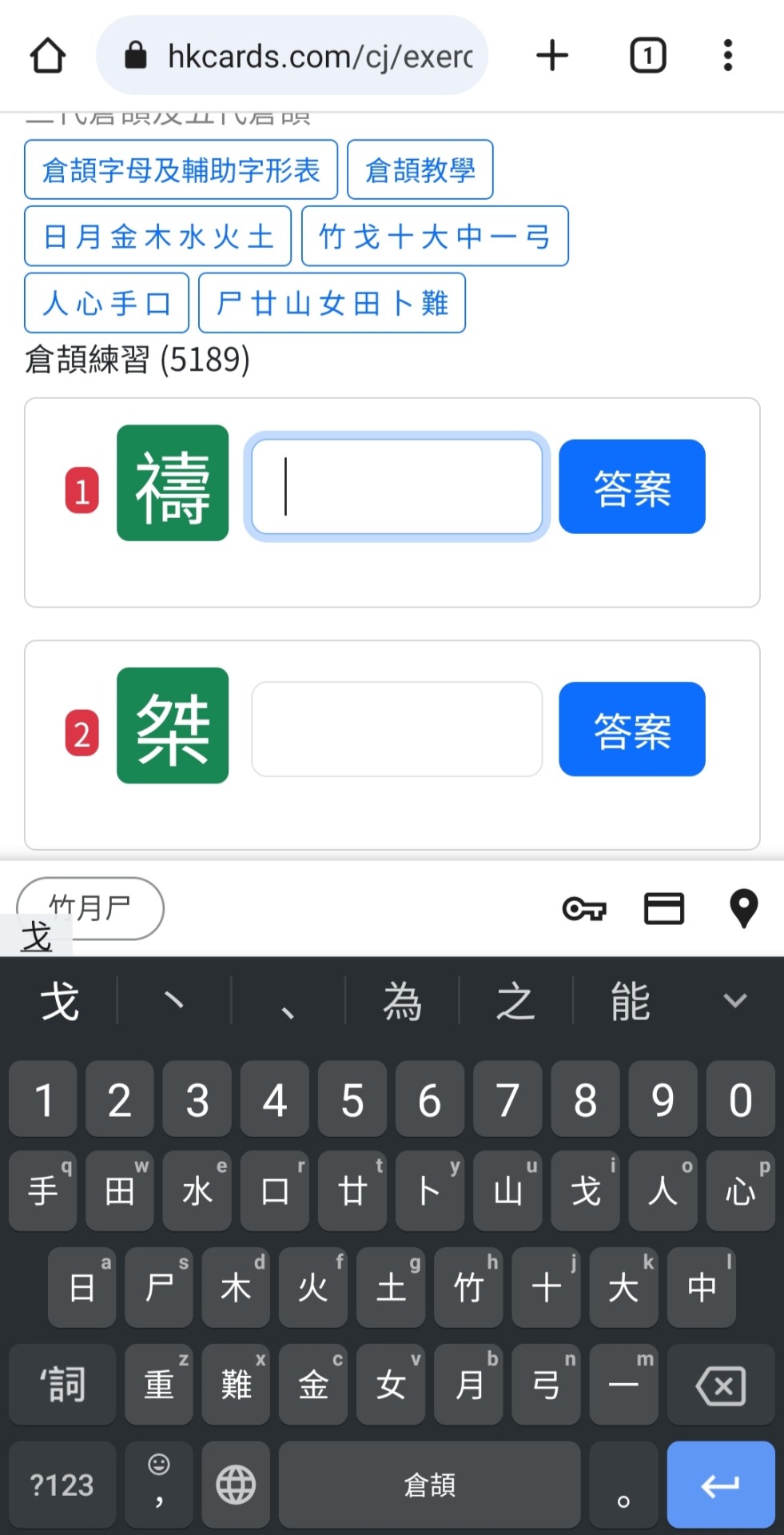

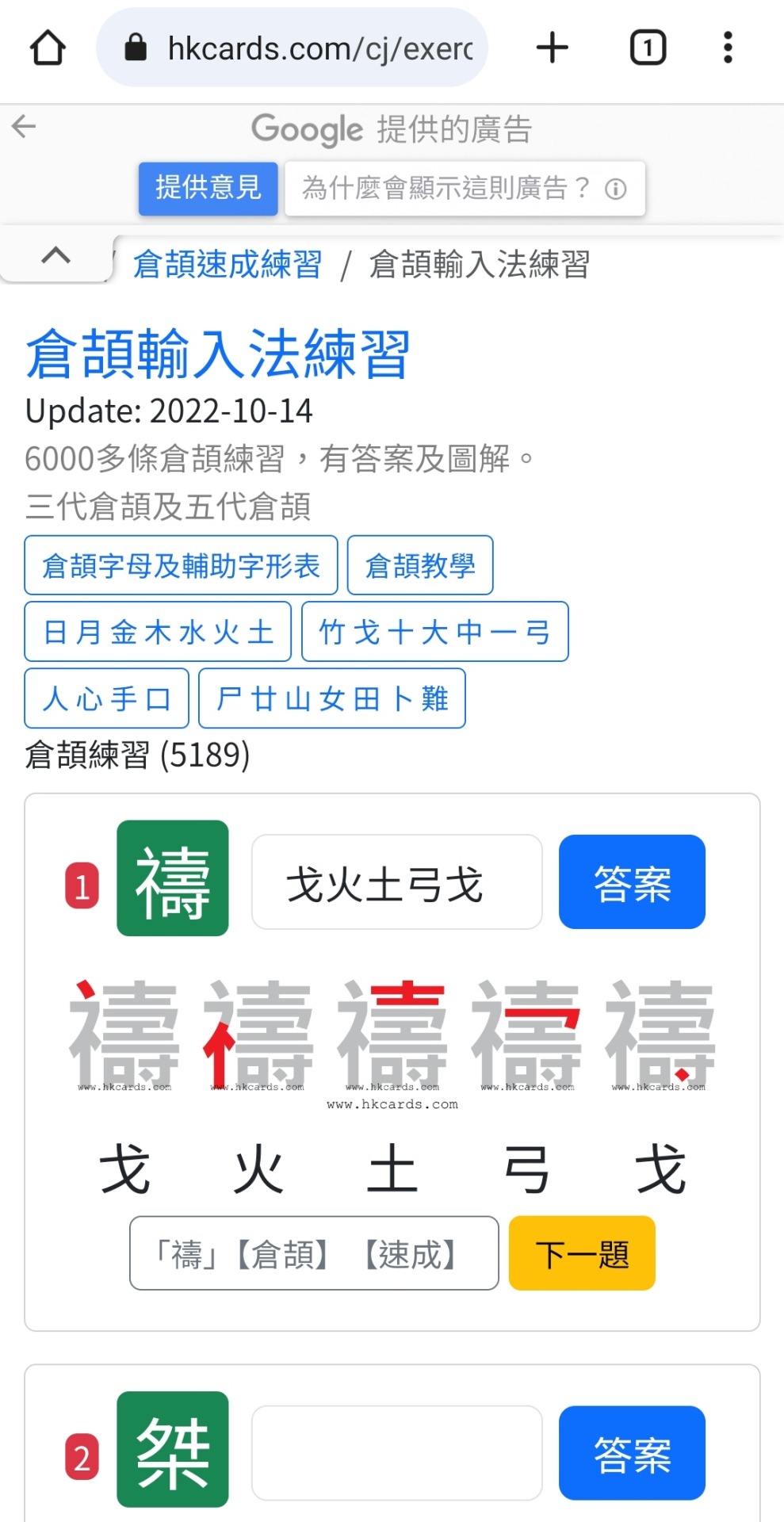
There are 8 characters each time, and you can just hit “Practise Again” (再做練習) to refresh for another 8 to practise with. I've yet to hit a limit.
Unfortunately, this website has lots of ads popping up. And it only supports searching in Traditional characters (Cāngjié was initially catered more for Traditional).
Or you can just try practising randomly with a Cāngjié keyboard and check for mistakes with a Cāngjié dictionary (『五色學倉頡』 app's dictionary comes in really useful here — it appears to support searching in Simplified too).
TL;DR
Cāngjié could be useful (and fun) to know if your 漢字/汉字 knowledge is already adequate, and/or you just like a new challenge.
And if watching videos is more your thing, here's a really helpful YouTube tutorial on how to use Cāngjié (has English subs)!
243 notes
·
View notes
Text
How I'm learning bopomofo (zhuyin fuhao)
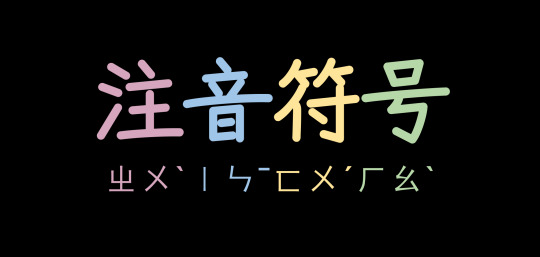
Why am I learning bopomofo?
Maybe around a year ago, I had a dream in which I was in a library/bookstore in Taiwan. I was trying to search their catalog to see if they had a book I wanted in stock. The only option was a bopomofo touchscreen keyboard, and I became quite distressed because I was unable to type anything. This dream inspired me to learn bopomofo, AKA zhuyin fuhao.
Why should you learn bopomofo?
Frankly, the consensus I've seen on blogs and language forums is that you don't need to learn bopomofo/zhuyin fuhao. But I wanted to share my thoughts on what there is to gain from learning it. Consider learning bopomofo if...
You find pinyin unintuitive or are looking for another input method for typing.
I learned pinyin very young, so it's second nature for me. But for some learners, it's difficult and may distract them from reading characters. Bopomofo offers an alternative.
You're really interested in Taiwanese culture and want to deepen your understanding of it.
My Taiwanese American friend tells me that you can find bopomofo in materials like children's books. I've also seen it used online, such as in it memes by Taiwanese netizens.
You're a total language nerd and think it would be fun.
It's been a fun challenge to learn something completely new to me after so many years of learning Chinese. It's forced me to reexamine the language and how pinyin works too!
How I'm learning bopomofo
My method is nothing fancy. First, I wrote down all the symbols my notebook and practiced converting syllables from pinyin to zhuyin fuhao. After that, I added the zhuyin keyboard to my phone and switched to practicing via typing.
As you may or may not know, I'm kind of obsessed with chengyu and try to learn a new one each day. So I practice typing with zhuyin fuhao daily by typing out my new chengyu of the day.
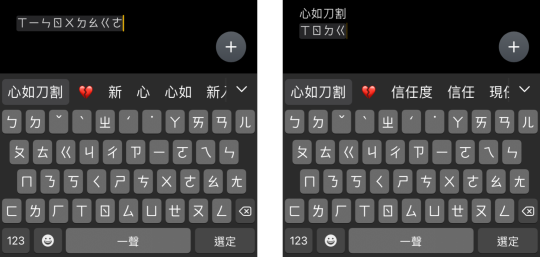
*Technically you are supposed to type the tone marks too, but I'm lazy and usually don't do that.
**Like with the pinyin keyboard, you can also input text by just typing the initials.
The downside of my method is that I fear I'm memorizing positions on the keyboard instead of the actual symbols. If you as me to read something written in zhuyin, I would need some time to decipher it. But I actually tried learning zhuyin previously using flashcards, and it didn't stick at all. So this typing method, while flawed, has worked for me because I've been able to practice consistently—a little bit every day!
I don't think I can write zhuyin out by hand, but I don't have to worry about my bad dream coming true anymore!
161 notes
·
View notes
Text
🌿🌕✨
外国的月亮比较圆 - “the moon is rounder in other countries”
A funny phrase I learned today, the equivalent of “the grass is always greener on the other side”!
Do you feel that way sometimes too? 🌝
389 notes
·
View notes
Text
*connects to sign language more than spoken language even though i’m not fluent, probably because of neurodivergency*
*learns a little Chinese Sign Language to help me in my Mandarin class*
And you know what? It’s actually working! The visual/movement cues associated with specific sounds, then associated with the words that HAVE those sounds, help me not mix up my pronunciations (especially with my “j” and “zh,” or my American “r” vs. Chinese “r”). And it’s clicking a lot more for me than pinyin really does, so any other Mandarin learners, I’d say try this out!

188 notes
·
View notes
Text
Chinese Music Recs: 2021 Update
I looked back at my blog archive and was surprised to see that my last music recommendations post was in November 2020—almost a year ago! Well I did have my Mandarin Music March challenge, but I’m not counting that. Here’s an update on what I’ve been listening to the last 6 months or so.
蔡健雅 / Tanya Chua
I have included Tanya Chua in past recommendation posts and featured a few of her songs on my blog, but I’ve been listening to her constantly this year, so I wanted to highlight her amazing music again. I am not a huge ballad/slow song fan, but I love hers. And she does great upbeat pop songs too.
Favorite album: 双栖动物(2005)
Favorite songs: 原谅、达尔文、坐立不安、无底洞、生锈的游乐场
沈以诚 / Eason Shen
Have you ever wondered what country-inspired Mandopop would sound like? Well you can find out right now. I discovered Eason Shen during my August challenge. He also has more typical pop songs, from slow and calm to uptempo to soulful.
Favorite album: 玩家(2020)
Favorite songs: 牛仔、寻宝、巴赫旧约(翻唱)、15楼窗外、形容
*First two songs are the ones with country influence.
林宥嘉 / Yoga Lin
Yoga Lin is another artist I’d heard of but overlooked for whatever reason. I checked out one of his albums during my August music challenge and instantly fell in love. He’s already become one of my top 10 most played artists of 2021. I would describe a lot of his music as pop rock.
Favorite album: 大小说家(2012)
Favorite songs: 白昼之月、唐人街、感同身受、慢一点、4号病房
莫文蔚 / Karen Mok
I made the mistake of not checking out Karen Mok earlier because I assumed most of her music was in Cantonese—she has actually released more Mandarin albums than Cantonese! Her older albums have some great rock-leaning and almost grungy tracks, and I love some of her more recent slow songs.
Favorite album: 如果没有你(2006)
Favorite songs: 境外、溜溜的情歌、懒得管、薄荷、女朋友的男朋友
Keep reading
178 notes
·
View notes
